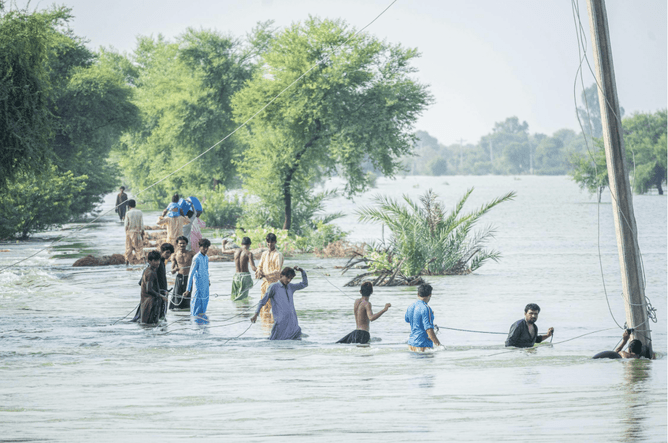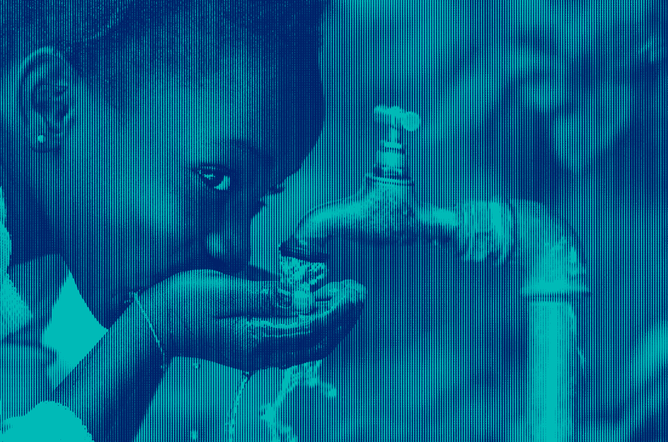Water at the Heart of the Climate Crisis
Extreme weather events, such as the raging wildfires in Los Angeles or the catastrophic floods in Pakistan, are no longer rare. In the past decade, climate-related disasters have displaced more than 20 million people annually, often driven by the dual forces of water scarcity and water excess (United Nations Office for Disaster Risk Reduction, 2020). These extremes highlight a reality: water lies at the very center of the climate crisis.
Water already affects much of our weather and climate, and as the earth warms, the water cycle is disrupted. The consequences are profound. Extreme weather is not just intensifying; it is fundamentally altering access to water, making it scarcer, more polluted, and more unpredictable. These disruptions threaten not only ecosystems and biodiversity, but also the basic human right to access clean water and sanitation.
Floods and rising sea levels contaminate water supplies with salt water and waste, causing vital infrastructure to fail, including wells, water points, and sanitation systems. Glaciers, ice caps, and snowfields are melting at alarming rates, threatening the freshwater sources that support millions of people. As these natural reservoirs disappear, water supplies that communities rely on for drinking, agriculture, and industry become increasingly scarce. This rapid melting also disrupts seasonal water cycles, causing floods in the short term and severe droughts in the long term, leaving millions vulnerable to water insecurity. Meanwhile, wildfires and droughts harm communities, exacerbate soil erosion, reduce groundwater recharge, and impair food security, forcing migration and fueling instability in vulnerable areas.
The increasing global demand for water adds to these challenges. Agriculture, energy, and urban development consume vast amounts of this limited resource. Currently, more than 1 billion people lack access to safe drinking water, and by 2050, 52% of the world's population is expected to live in water-stressed regions. Degraded peatlands and wetlands lose their ability to absorb carbon dioxide, and intensive farming, especially for the production of livestock and biofuels, depletes freshwater supplies. Meanwhile, industrialization and urbanization further strain resources, with global private investment in water security projected to grow from $800 billion in 2024 to $6.9 trillion by 2034, reflecting the urgency of addressing these issues (Water Unite, 2025).
Water is not only a casualty of climate change; it is a driver for a wider social and economic crisis. Understanding these links is crucial not only for disaster mitigation, but also for ensuring long-term development and resilience in the coming years. In a world that is changing quickly, this article investigates the consequences of climatic extremes on water.
The Twin Threats of Flood and Drought
The contradiction of extreme weather is evident: the same areas struggle with destructive floods one year and then encounter serious droughts the following year. Similarly, areas that endure biting cold and heavy snowfall can later experience water shortages as snowmelt patterns shift unpredictably. This paradox reveals the fragility of our global water systems, where excess and scarcity often go hand in hand.
In 2022, Pakistan experienced catastrophic flooding that affected 33 million people and led to at least 1,033 deaths (UN Office for the Coordination of Humanitarian Affairs, 2022). Millions of people were displaced, and entire communities were left in ruin. The floods contaminated water supplies with salt water and waste, spreading waterborne diseases such as cholera and typhoid. The destruction extended to critical infrastructure, including wells and wastewater treatment facilities, leaving many people without access to clean water (Britannica, 2022). The humanitarian crisis did not end when the floodwaters receded: long-term water shortages, damaged farmlands, and health crises persisted, showcasing how floods have far-reaching impacts beyond immediate destruction.
In contrast, prolonged droughts are equally destructive yet often move slower. The situation has been further exacerbated by recent wildfires, such as the Palisades Fire in Los Angeles, which scorched over 23,000 acres, destroyed approximately 6,831 structures, and claimed at least 29 lives (MacCarthy & Richter, 2025). Farmers have been forced to cut back on water-intensive crops, which disrupts food supplies and increases prices, placing additional burdens on already vulnerable populations. Similarly, the drought in Central Asia and the Caucasus from 2000 to 2001 inflicted devastation on Armenia, Azerbaijan, Georgia, Tajikistan, and Uzbekistan communities. Relief efforts for food, water, and agriculture cost an estimated $190 million, underscoring the immense economic toll of water scarcity (The World Bank, 2005).
Though floods and droughts seem like opposite extremes, they are deeply interconnected. Poor water management, failing infrastructure, and unsustainable land use often amplify these disasters. Without long-term planning, regions will continue to swing between too much and too little water, causing repeated humanitarian crises.
Global Impacts of Extreme Weather on Water Systems
Extreme weather events have far-reaching impacts on water systems, affecting urban centers, rural communities, and developing countries equally. Their effects have consequences across economies, ecosystems, and public health, making water security one of today's most critical climate issues.
Urban areas, often dependent on aging infrastructure, face increasing strain as demand rises and resources deplete. Cape Town’s near “Day Zero” crisis is a reminder of the vulnerabilities cities face when water supplies are pushed to the limit. The city narrowly avoided running out of water entirely, highlighting the urgent need for modernized infrastructure and proactive planning to meet the challenges of extreme weather (Hill-Lewis, 2023).
In rural communities, the reliance on rain-fed agriculture and local water bodies leaves populations particularly vulnerable to the effects of drought. Water scarcity damages crops, animals, and livelihoods, generating a cascading effect that intensifies poverty and food insecurity. For instance, the 2015 drought in Idaho, Oregon, and Washington caused an estimated $1 billion in agricultural damages, illustrating how climate extremes can have devastating economic consequences in developed nations as well (USDA Northwest Climate Hub, 2022).
In developing nations, the impacts are magnified by limited resources and infrastructure, which make it difficult to adapt to and recover from extreme weather. Millions of people in these regions lack access to adequate water and sanitation, leaving them further exposed to the consequences of climate change (Teng & Donnellon-May, 2022). Currently, 2.4 billion people live in water-stressed countries, where access to clean water is already fragile (Li, 2023). Without action, this number will rise, intensifying social inequality and geopolitical instability.
The Value of Water Beyond Utility
Water’s importance extends far beyond its basic utility. It is a cornerstone of economic resilience, cultural identity, and biodiversity. Agriculture and hydropower depend on steady water supplies, and disruptions caused by extreme weather destabilize these systems, leading to economic and social instability. Water also holds profound cultural significance, playing a central role in traditions, rituals, and the fabric of communities worldwide.
Beyond human needs, water is essential to sustaining ecosystems, particularly in fragile climates where biodiversity depends on reliable water cycles. The effects of water system disruptions threaten not only the environment but also the livelihoods of millions who depend on them.
However, innovative solutions are offering hope. Circular water systems that recycle wastewater are providing sustainable ways to address scarcity, while models like Water Unite’s micro-contributions demonstrate how collective consumers' effort can have a profound global impact.
Restoring natural watersheds, as seen in Cape Town, provides cost-effective solutions to water security challenges by enhancing natural water sources (The Nature Conservancy & Water Funds for Africa, 2019). This approach, supported by Water Unite through the Water Fund, presents a sustainable alternative to costly infrastructure projects. These solutions align with Sustainable Development Goal 6, emphasizing the critical role of water in mitigating the impacts of extreme weather and building resilience against future crises.
Water is not just a resource; it is the lifeblood of communities, economies, and ecosystems. The urgency to protect and manage it has never been greater. By recognizing its multifaceted value and addressing the challenges posed by extreme weather, we can safeguard the future for generations to come.
Building Future Resilience
At Water Unite, we recognize that resilience against extreme weather requires targeted, data-driven solutions that address both immediate risks and long-term sustainability. Through our Water+ investment thesis, we tackle these challenges by improving water security, advancing sanitation infrastructure, and promoting circular economy initiatives that enhance resource efficiency and climate adaptation.
Partners like Jibu are pioneering decentralized water treatment solutions, ensuring communities have reliable access to clean water even during climate disasters. Meanwhile, Sanivation is building climate-resilient sanitation infrastructure, converting waste into valuable resources to support long-term sustainability. Seabex, using AI-driven water optimization, helps farmers adapt to unpredictable weather while conserving precious resources.
Our micro-levy model, backed by corporate partners, channels vital funding into these innovative solutions. Every purchase from partner brands contributes to a more resilient water future. By blending corporate contributions with investment capital, we scale impactful projects that help communities withstand extreme weather.
The relationship between climate change and water security will only grow more urgent in the coming years. However, there is still time to act. By supporting brands that partner with Water Unite, advocating for stronger climate policies, and adopting sustainable water practices, individuals can play a meaningful role in securing our global water future.
Water is not just a resource, it is the foundation of life, security, and economic stability. The choices we make today will determine whether future generations face worsening crises or a more resilient, water-secure world.
References
Britannica. (2022). Pakistan floods of 2022 | Damage, Causes, Effects, & Facts | Britannica. Encyclopedia Britannica. https://www.britannica.com/event/Pakistan-floods-of-2022
Hill-Lewis, G. (2023, March 22). Cape Town: Lessons from managing water scarcity. Brookings. https://www.brookings.edu/articles/cape-town-lessons-from-managing-water-scarcity/
Li, L. (2023, October 16). Water Scarcity, the Climate Crisis and Global Food Security: A Call for Collaborative Action. United Nations. https://www.un.org/en/un-chronicle/water-scarcity-climate-crisis-and-global-food-security-call-collaborative-action
MacCarthy, J., & Richter, J. (2025, January 9). 4 Graphics Explain Los Angeles’ Rare and Devastating January Fires. World Resources Institute. https://www.wri.org/insights/los-angeles-fires-january-2025-explained
Rodina, L. (2019). Water resilience lessons from Cape Town’s water crisis. Wiley Interdisciplinary Reviews: Water, 6(6). https://doi.org/10.1002/wat2.1376
Teng, P., & Donnellon-May, G. (2022, June 21). Global Water Crisis: Options for Food Security. Nanyang Technological University. https://www.rsis.edu.sg/rsis-publication/nts/growing-food-insecurity-global-water-crisis-options-for-food-security/
The Nature Conservancy, & Water Funds for Africa. (2019). Greater Cape Town Water Fund Business Case. https://www.nature.org/content/dam/tnc/nature/en/documents/GCTWF-Business-Case-April-2019.pdf
The World Bank. (2005, March 11). Drought : Management and Mitigation Assessment for Central Asia and the Caucasus. Handle.net. https://hdl.handle.net/10986/8724
UN Office for the Coordination of Humanitarian Affairs. (2022, December 9). Pakistan 2022 Floods Response Plan Interim Report. https://reliefweb.int/report/pakistan/pakistan-2022-floods-response-plan-interim-report-sep-nov-2022-issued-09-dec-2022
United Nations Office for Disaster Risk Reduction. (2020, March 20). Scaling up DRR in Humanitarian. Undrr.org. https://www.undrr.org/news/scaling-drr-humanitarian/development-contexts
USDA Northwest Climate Hub. (2022). Drought and Northwest Agriculture in a Changing Climate. Usda.gov. https://www.climatehubs.usda.gov/hubs/northwest/topic/drought-and-northwest-agriculture-changing-climate
World Health Organization Regional Office for Europe. (2011). Guidance on Water Supply and Sanitation In Extreme Weather Events. https://iris.who.int/bitstream/handle/10665/326379/9789289002585-eng.pdf



